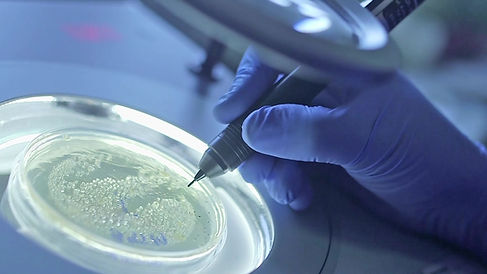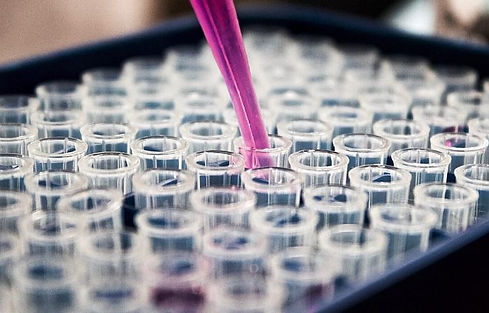

Benefits of Polycaps Technology
Enhanced Stability
Protects active substances from degradation during production, storage and transportation .
Improved Absorption
Ensures that active substances are released and absorbed at the optimal location within the body.
Versatility
Applicable to a wide range of active substances and product formulations.
Compliance with Industry Standards
Our production processes adhere to the highest manufacturing standards for food and pharmaceuticals, ensuring safety and quality.
Innovation - Driven Solutions
Polycaps is a pioneering company specializing in advanced microencapsulation technology. We develop innovative solutions for the encapsulation of sensitive active substances (AS) in a protective micro coating. This technology ensures that these substances remain stable and effective, even under the harsh conditions of food and pharmaceutical production. Our mission is to enhance the quality, longevity, and performance of products across various industries by leveraging the power of our unique patented process of microencapsulation coating.

The Next Generation of the Food and Pharma
Our patented microencapsulation technology is breakthrough as not only enhances the quality and performance of your products but also ensures targeted and controlled release of active ingredients.
Join us in transforming the future of food and pharmaceutical industries with our innovative, resilient, and high-performance microencapsulation solutions. Experience the cutting-edge of stability

Patent List
MOISTURE RESISTANT PROBIOTIC GRANULE AND METHODS OF PRODUCING THE SAME Application
- Publication/Patent Number: EP3781137A4 Publication Date: 2022-01-05 Application Number:
EP19787939
- Publication/Patent Number: US20210186887A1 Publication Date: 2021-06-24 Application Number:
US17/048,614
- Publication/Patent Number: BR112020021458A2 Publication Date: 2021-01-19 Application Number:
BR112020021458
- Publication/Patent Number: EP3781137A1 Publication Date: 2021-02-24 Application Number:
EP19787939.8
- Publication/Patent Number: AU2019255435A1 Publication Date: 2020-11-26 Application Number:
AU2019255435
- Publication/Patent Number: IL278101D0 Publication Date: 2020-11-30Application Number:
IL27810120
- Publication/Patent Number: IL278101A Publication Date: 2020-11-30 Application Number:
IL27810120
- Publication/Patent Number: CA3097489A1 Publication Date: 2019-10-24 Application Number:
CA3097489
- Publication/Patent Number: WO2019202604A1 Publication Date: 2019-10-24 Application Number:
IL2019/050454
Applications

Polycaps microencapsulation technology is versatile and can be applied across various industries:
∙Food Industry: Enhances the stability and effectiveness of vitamins, minerals, probiotics, and other sensitive ingredients in food products.
∙Pharmaceutical Industry: Improves the delivery and efficacy of drugs, ensuring that active substances are released at the right place and time within the body.
By leveraging our advanced microencapsulation technology, Polycaps is committed to driving innovation and excellence in product development, ultimately improving the quality and performance of food and pharmaceutical products
Polycaps: Application Examples
Food Industry Examples for Applications

Microencapsulation technology offers numerous benefits for the food industry by enhancing the stability and effectiveness of active ingredients. Here are some examples:
∙Vitamins and Minerals: Microencapsulation protects sensitive vitamins and minerals from degradation during processing and storage, ensuring they retain their nutritional value until consumption.
∙Probiotics: Encapsulating probiotics helps them survive the acidic environment of the stomach, allowing them to reach the intestines where they can provide health benefits.
∙Flavors and Aromas: Microencapsulation can mask flavors and aromas, enabling the addition of substances like omega-3 and CBD/THC without altering the product’s taste.
∙Omega-3 Fatty Acids: Microencapsulation can affect the absorption process, allowing omega-3 to be absorbed in the duodenum. This helps balance blood sugar levels and contributes to a feeling of satiety (Increased GLP-1).
∙Lactoferrin: Microencapsulation enhances the stability of lactoferrin during heating and improves its absorption. This allows manufacturers to use smaller amounts of lactoferrin while enhancing its delivery and bioavailability.
Pharmaceutical Industry Examples for Applications
%20can%20be%20seamlessly%20added%20during%20production%20pro.jpg)
In the pharmaceutical industry, microencapsulation enhances drug delivery and efficacy. Here are some applications:
∙Controlled Release Medications: Microencapsulation allows for the controlled release of drugs, ensuring they are delivered at the right time and place within the body, improving therapeutic outcomes.
∙Taste Masking: microencapsulating bitter-tasting drugs can mask their taste, making them more palatable for patients, especially children.
∙Protection of Sensitive Drugs: Some drugs are sensitive to environmental conditions.
Microencapsulation protects these drugs from degradation, ensuring their effectiveness.
∙Targeted Drug Delivery: Microencapsulation can be used to target specific areas of the body, reducing side effects and improving the efficacy of treatments.
Applications Ready for Use
Pastry Industries

Candies & Gummies Industries

By leveraging our advanced microencapsulation systems, we can protect probiotic bacteria (PB) and Omega-3 against various risk factors throughout different handling processes. This enables their incorporation into final products like bakery goods.
Protection Process:
-
Core Preparation:
-
Method: Granulating Bifidobacterium lactis (BL) and Omega-3 to form a core.
-
Goal: Ensure the stability of BL and Omega-3 against denaturation using a specific immobilization process.
-
-
Core Coating:
-
Method: Applying three protective layers.
-
Goal: Safeguard BL and Omega-3 against extreme temperatures and low pH levels during final product integration.
-
Key Benefits:
-
Enhanced Stability: Ensures BL and Omega-3 remain stable and effective.
-
Product Expansion: Enables incorporation into bakery goods and other products, broadening the range of probiotic and Omega-3 benefits.(GLP-1 create satisfaction)
This innovative technology not only stabilizes probiotics and Omega-3 but also expands their application, transforming how we integrate active substances into food products.
Incorporation of our microencapsules AS in gummies which were produced using Baker Perkins facilities and equipment, recipes (starchless process) and ingredients and tested in the analytical and microbiological laboratories of Eurofins.
Active Substances Content for each gummy (serving size):
DHA – 25 mg intact and safe DHA
Probiotic – CFU of 4 x 108 – Bifidobacteria lactis
Melatonin – 6 mg intact and safe melatonin
Caffeine – 60 mg totally taste-masked in sugar free gummy
Collagen – 200 mg in pectin-based gummy
Protein – 300 mg in pectin-based gummy
Lactoferrin – 50 mg intact and safe lactoferrin
Example of additional uses
Chocolate, Jellies, Snack Bars, Candies, Cereals, Chewing Gum...
Lactoferrin for Baby Formula and Nutrition Supplements

Stabilize lactoferrin against various risk factors throughout different handling processes. This enables its incorporation into final products like PIF and liquid infant formula (LIF).
Stabilization Process:
-
Core Preparation:
-
Method: Agglomeration of lactoferrin with specific food-grade ingredients.
-
Goal: Prevent denaturation using a solid-state immobilization process, ensuring lactoferrin's stability.
-
-
Core Coating:
-
Method: Applying specific formulation layers.
-
Goal: Protect lactoferrin against harsh conditions during final product integration.
-
Key Benefits:
-
Stabilization: Ensures lactoferrin remains stable and effective.
-
Targeted Delivery: Provides site-specific delivery through the GI tract.
Stabilizes enzymes but also enhances the targeted delivery of lactoferrin, transforming how we incorporate active substances into food and pharmaceutical products.
Dairy Products with sensitive active substances (AS) -Yogurt

-
Cell Count: Final microencapsulated bacteria contain 5E10-1E11 CFU per gram of powder, depending on the initial cell count of the pure bacteria.
-
Shelf Life: At least 2 years when stored under cooled conditions.
-
Dosage: 0.02%-0.005% w/w of microcapsule per gram of yogurt ensures viability of 1E6-1E7 CFU per gram at the end of the shelf life..
Production:
-
Microcapsules for each active core were produced using Romaco-Innojet Ventilus equipment, featuring its unique and patented Hotmelt Coating device.
-
Microencapsulated L. rhamnosus, combined with starting cultures and lactase, maintained viability throughout the yogurt production process, including fermentation and pasteurization (72°C for 15 seconds), with no viability loss.
-
Viability of bacteria was fully preserved during the yogurt's shelf life.
